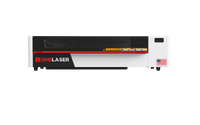If you’ve ever shopped for a laser engraver, you’ve probably seen big, bold numbers like “Work speed up to 1200 mm/s!” or “Cut at lightning-fast vector speeds!” plastered across marketing materials.
But here’s the truth—those numbers don’t always tell the full story.
In the world of laser engraving, speed and power are two of the most misunderstood specifications. While they sound simple, they interact in complex ways that directly determine the engraving quality, cutting precision, and overall performance of your machine.
Key Takeaway
In this article, we’ll break down what laser engraving speed and power actually mean, how they work together, and what numbers you should really pay attention to—based on transparent, real-world benchmarks used by professional-grade systems like the OneLaser X Series.
1. Why Laser Speed Specs Can Be Misleading
The laser industry is full of impressive-sounding numbers—but not all are created equal.
When a brand claims “engraving speed = 1200 mm/s,” it’s often referring to an ideal mechanical movement, not the real processing speed you’ll experience while engraving detailed patterns or bitmap images.
That’s why OneLaser decided to redefine how engraving speed is measured by publishing three distinct and realistic speed dimensions:
- Raster Engraving Speed (RES)
- Vector Maximum Speed (VMS)
- Real-Time Acceleration (RTA)
These three values give a complete picture of how fast—and how accurately—a machine truly performs in real engraving conditions.
2. The Three Dimensions of True Laser Speed
2.1 Raster Engraving Speed (RES)
Raster engraving speed refers to how quickly the laser head moves back and forth while engraving images, grayscale photos, or bitmap patterns.

This is the most common type of engraving for logos, artwork, and photo reproduction. The higher the RES, the faster your laser can complete image-based jobs without sacrificing detail.
- Example: The OneLaser XRF delivers a RES of 1200 mm/s, supported by its high-frequency RF CO₂ metal tube (up to 100 kHz switching).
- Why it matters: Raster engraving showcases the laser’s true capability—it’s where precision, focus stability, and motion control all come together.
2.2 Vector Maximum Speed (VMS)
Vector speed represents how quickly the laser can travel along path-based lines or cutting vectors—ideal for outlines, shapes, and cutting tasks.

However, these values can be deceiving. While some brands list VMS numbers like 1200–1500 mm/s, that performance usually occurs only during long straight-line runs on very large work areas. In most real-world projects involving curves or short lines, the machine never reaches those top speeds.
- Reality check: Actual engraving speed on laser vector paths rarely exceeds 600 mm/s, because acceleration and deceleration limits prevent the head from maintaining high velocity through tight curves.
2.3 Real-Time Acceleration (RTA)
Acceleration determines how quickly the laser head can speed up or slow down while maintaining accuracy. It’s measured in “G-force” (G).
Higher RTA means smoother transitions, sharper detail, and less burn distortion at corners or edges.
- OneLaser XRF RTA = 3G — delivering both speed and precision.
- By contrast, most entry-level DC glass-tube systems operate around 1–2 G, resulting in slower motion and less consistent results.
3. How Speed and Power Work Together
Think of speed and power as two sides of the same coin. Both must be balanced to achieve clean, high-quality results.
- Speed = how fast the laser head moves.
- Power = how much energy the laser emits onto the surface.
Too much power with low speed can overburn the material; too little power with high speed can cause weak or incomplete engraving.
For example:
- Engraving wood: medium power (40–60 %) and moderate speed often yield crisp contrast.
- Cutting acrylic: lower speed but higher power ensures a clean, flame-polished edge.
The goal is finding the optimal combination—where the laser cuts or engraves efficiently without sacrificing precision or causing thermal damage.
4. Laser Cutting Speed vs Engraving Speed
While both are expressed in mm/s, cutting speed and engraving speed describe two different processes.
- Laser cutting speed applies to vector cutting through materials. It depends heavily on laser power, focus depth, and material thickness.
- Laser engraving speed applies to surface etching—usually faster because it removes only microns of material.
|
Task |
Typical Speed Range |
Power Use |
Purpose |
|
Raster Engraving |
300–1200 mm/s |
30–70 % |
Etching graphics, photos |
|
Vector Engraving |
100–600 mm/s |
40–80 % |
Outlines, text |
|
Cutting |
10–300 mm/s |
60–100 % |
Full-depth cuts |
Understanding these distinctions helps you interpret specification sheets more accurately—and set realistic expectations for job times.
5. Why “1200 mm/s” Doesn’t Mean What You Think
Let’s illustrate this with a practical example:
Many machines boast a work speed of 1200 mm/s. But under real conditions—say, engraving a 100 mm logo—your laser never actually reaches that velocity.
That maximum speed is typically recorded under ideal large-format conditions (for instance, a 900 mm scan length with 2 G acceleration). In smaller or more complex engravings, the laser head spends more time accelerating and decelerating than traveling at top speed.
In real-world projects, actual engraving speed is often closer to 300–500 mm/s—a huge difference from the advertised figure.
This is why it’s critical to look beyond marketing claims and focus on measured RES, VMS, and RTA values to understand true performance.
6. Why Acceleration and Controller Type Matter
6.1 Acceleration (RTA)
Acceleration governs how efficiently a laser transitions between movements.
- High RTA (3 G+) = sharp corners, precise details, consistent shading.
- Low RTA (1–2 G) = blurred edges, vibration artifacts, inconsistent depth.
6.2 Controller Type
The controller is the brain of your laser. It determines how accurately speed and power are synchronized.
- DSP Controllers (like in OneLaser XRF): provide dedicated motion algorithms and real-time laser modulation, ideal for high-speed bitmap engraving.

- G-Code Controllers: commonly used in hobby-grade machines, flexible but less precise at high speeds—can result in micro-stutters or uneven burn marks.
The combination of a 3 G motion system with a DSP controller ensures that laser engraving speed and power remain perfectly balanced, even at 1200 mm/s RES.
7. How Laser Tube Technology Affects Speed
Your laser tube determines how fast it can pulse—known as switching frequency—and that directly impacts engraving performance.
|
Feature |
RF Metal Tube |
DC Glass Tube |
|
Switching Frequency |
50–100 kHz |
1–5 kHz |
|
Typical Resolution |
1000–2000 DPI |
300–600 DPI |
|
Cooling |
Air |
Water |
|
Lifespan |
20,000 + hrs |
1,000–3,000 hrs |
|
Response Speed |
Ultra-fast |
Slower |
|
Maintenance |
Low |
High |
The RF tube’s 20× faster modulation means it can pulse thousands of times per second—engraving ultra-fine dots at high DPI without delay. This allows real raster engraving speeds up to 1200 mm/s with smooth tonal gradients, while DC glass tubes max out around 400 mm/s.

8. Balancing Speed, Power, and Precision in Practice
Here’s how to approach real-world settings for optimal results:
- Start with material guidelines. Every surface (wood, acrylic, leather, glass) reacts differently to heat and speed.
- Test small patches. Incrementally increase speed until engraving becomes faint, then back off slightly.
- Adjust power accordingly. More power compensates for faster speeds, but too much can cause burns.
- Use proper focus and air assist. A clean focal point ensures consistent energy delivery.
- Enable dithering or grayscale modes for photo engraving to maintain tonal depth even at higher speeds.
The key is not just to go fast—but to engrave efficiently while keeping quality high.
Engineer 1-on-1 Training and Support
9. Real-World Example: OneLaser XRF Performance
The OneLaser XRF Series provides a transparent benchmark for users who value measurable performance over marketing hype.
- RES: 1200 mm/s
- VMS: 1400 mm/s
- RTA: 3 G
- Tube: RF CO₂ metal, 38 W or 55 W
- Controller: DSP
This configuration ensures that both laser engraving speed and power are delivered precisely where they matter—during real production jobs, not just lab demos.
The result? Smooth gradients, crisp vector lines, and shorter production times without compromising on resolution or consistency.
10. FAQs
What is the best speed and power for laser engraving?
It depends on your material and design. For example, engraving wood often works well around 400–600 mm/s at 40–60 % power, while acrylic needs slower speed and higher power for depth. Always start with test patches to find your optimal settings.
What is the difference between speed and power in laser?
Speed controls how fast the head moves; power controls how much energy the beam emits. Together, they define burn depth, contrast, and edge quality. Too fast = faint marks; too powerful = charred surfaces.
How does speed affect laser engraving?
Speed affects exposure time. Faster speeds reduce burn depth but increase throughput. Slower speeds deepen marks but can overheat materials. Balancing both maintains consistent shading and fine detail.
How fast is laser engraving?
Professional RF CO₂ systems like the OneLaser XRF can reach 1200 mm/s for raster engraving, while hobby-grade DC glass-tube lasers typically stay between 300–500 mm/s. Real speed also depends on job complexity and acceleration.
What’s the difference between engraving speed and cutting speed?
Engraving speed is for surface marking—fast, shallow, and detailed. Cutting speed is for full-depth passes—slower but with higher power. Engraving focuses on precision; cutting focuses on penetration.
Why do advertised maximum speeds differ from real results?
Manufacturers often measure speed with the laser off, on long straight lines, or at minimal acceleration. Real engraving involves frequent starts, stops, and curves—reducing effective speed by 50–70 %.
How can I improve my engraving speed without losing detail?
- Use higher acceleration (3 G or more).
- Choose an RF metal tube for faster modulation.
- Maintain optimal focus and clean optics.
- Use a DSP controller for smooth motion.
- Enable air assist to prevent burn buildup.
Have Questions? Join Our Forum!
Final Thoughts
Speed and power figures look great on paper—but performance in the laser world is all about control and consistency.
By understanding how raster engraving speed, vector speed, and acceleration work together, you’ll see why machines like the OneLaser XRF Series stand out for genuine productivity, not inflated claims.
Next time you evaluate a laser cutter or engraver, don’t just ask “How fast is it?”—ask “How fast does it engrave accurately?”
That’s where true innovation—and real return on investment—shines.

 Liquid error (sections/image-banner line 171): invalid url input
Liquid error (sections/image-banner line 171): invalid url input





